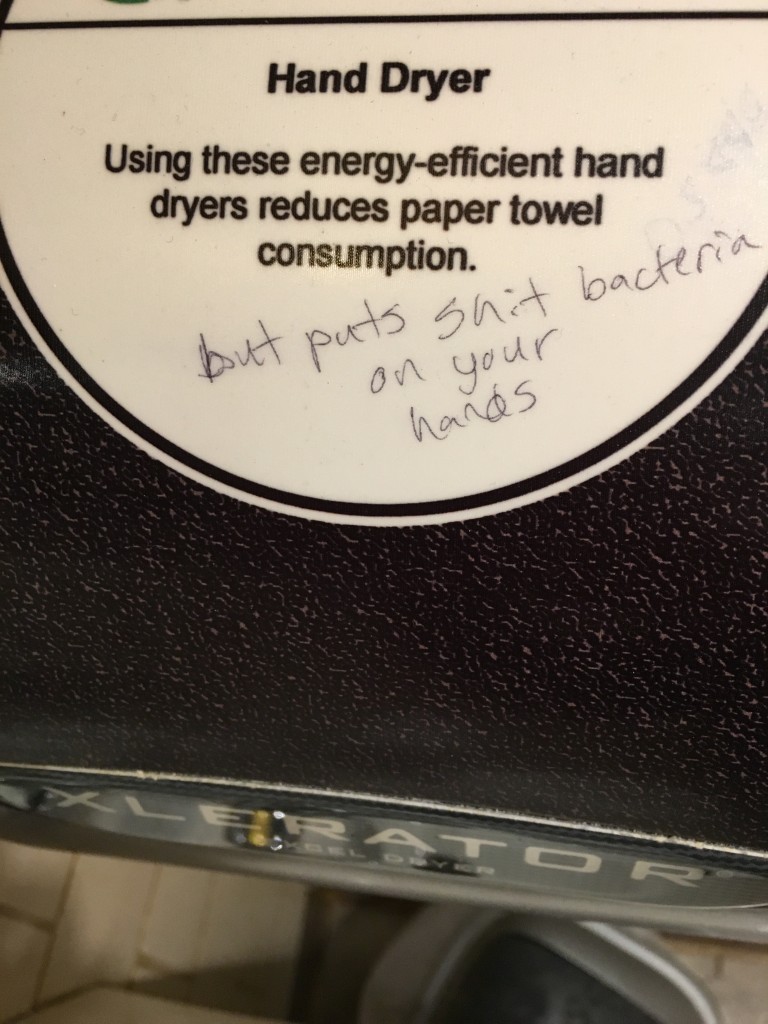I’m a food safety voyeur.
Supermarkets, farmers markets, restaurants – fancy or not – kitchens, farms, I’ve been professionally watching people for 20 years.
 Chapman likes to recount how he was invited to the GFSI Consumer Goods Forum as a last minute replacement speaker in 2013 to talk about food safety infosheets and how we evaluated them. He said that the literature shows surprise matters when it comes to communicating risks – and a message that is up all the time, like a hand washing sign, probably doesn’t do much after the day it was posted (when it is surprising to the food handler).
Chapman likes to recount how he was invited to the GFSI Consumer Goods Forum as a last minute replacement speaker in 2013 to talk about food safety infosheets and how we evaluated them. He said that the literature shows surprise matters when it comes to communicating risks – and a message that is up all the time, like a hand washing sign, probably doesn’t do much after the day it was posted (when it is surprising to the food handler).
The level of surprise in a message determines how successfully the information is received. In 1948, the Bell Telephone Company commissioned a study on communication as a mathematical theory to aid in the design of telephones. In a study of brain function, Zaghloul and colleagues (2009) also showed the brain’s sensitivity to unexpected or surprising information plays a fundamental role in the learning and adoption of new behaviors.
During the Q&A session at the end of the session someone from a German retail store asked Chapman if he was suggesting that that they take down all the handwashing posters they had up, and Chapman said, yes, unless they plan on changing them every couple of days. The audience had an audible gasp.
We’ve found that posting graphical, concise food safety stories in the back kitchens of restaurants can help reduce dangerous food safety practices and create a workplace culture that values safe food.
It was the first time that a communication intervention such as food safety information sheets had been validated to work using direct video observation in eight commercial restaurant kitchens and was published in the Journal of Food Protection.
 We found that infosheets decreased cross-contamination events by 20 per cent, and increased handwashing attempts by 7 per cent.
We found that infosheets decreased cross-contamination events by 20 per cent, and increased handwashing attempts by 7 per cent.
Based on observations of more than 5,000 patrons at a hospital-based cafeteria, we showed that an evidence-based informational poster can increase attempts at hand hygiene.
So we gladly welcome new work on food safety messages and media in poultry processing facilities.
Signs can provide repetitive training on specific food safety practices for multicultural food processing employees. Posted signs for workers in many food processing facilities tend to be text-heavy and focus specifically on occupational hazard safety. The purpose of this study was to evaluate the effectiveness of newly-developed hand washing pictograms on employees’ hand washing behavior using video observation.
Five employee hand washing behaviors (soap use, wash completeness, wash time, complete rinsing, and towel use) were evaluated with (a) no intervention, company signs posted and considered the baseline; and compared to (b) hand washing behavior the next day (short term) and two weeks (long term) after experimental hand washing signs were displayed at a raw poultry slaughter facility (Facility A) and a poultry further processing facility (Facility B).
 Both facilities showed a significant increase (p < 0.05) in soap use after the new sign was introduced at both short and long term time periods. There was a significant increase (p < 0.05) in washing, time of washing, and rinsing observed by Facility B employees, when baseline data was compared to the short term. This indicates that a new sign could increase hand washing compliance at least in the short term. Sign color also had a significant effect (p < 0.05) on employee behavior for washing and time of washing. Behavior for four of the five variables (soap, wash, time of wash, and towel use) was significantly different (p < 0.05) between baseline and either experimental observation period.
Both facilities showed a significant increase (p < 0.05) in soap use after the new sign was introduced at both short and long term time periods. There was a significant increase (p < 0.05) in washing, time of washing, and rinsing observed by Facility B employees, when baseline data was compared to the short term. This indicates that a new sign could increase hand washing compliance at least in the short term. Sign color also had a significant effect (p < 0.05) on employee behavior for washing and time of washing. Behavior for four of the five variables (soap, wash, time of wash, and towel use) was significantly different (p < 0.05) between baseline and either experimental observation period.
While signs can be a useful tool to offer as recurring food safety training for food processing employees, employees tend to revert back to old habits after several weeks.
Evaluation of how different signs affect poultry processing employees’ hand washing practices
Food Control, Volume 68, October 2016, Pages 1–6
Matthew Schroeder, Lily Yang, Joseph Eifert, Renee Boyer, Melissa Chase, Sergio Nieto-Montenegro
http://www.sciencedirect.com/science/article/pii/S0956713516301244










